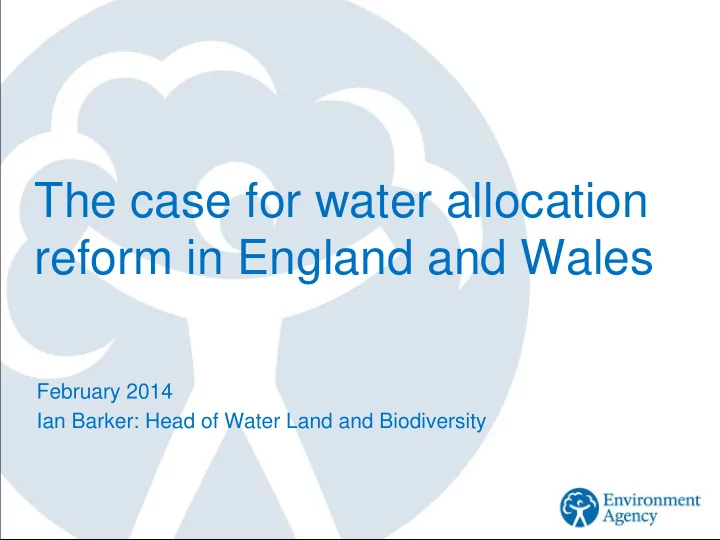

The case for water allocation reform in England and Wales February 2014 Ian Barker: Head of Water Land and Biodiversity
Water abstraction Around 38,000 million litres abstracted per day Used for a wide range of purposes Current system set up in 1960s Protects abstractors’ rights Has been adapted to provide environmental protection Run by Environment Agency and Natural Resources Wales
Why reform and why now? Resources already under pressure Climate change will affect flow patterns Population growth will increase demand Current system is not flexible enough to cope with the changing demands on water resources
Problems with the current system Problem Possible solutions Abstraction is not closely linked to Link abstraction to availability rather water availability / flows than season, improve allocation of peaks and protect low flows Charging does not discourage waste Introduce a charging system that reflects usage Some people have more than they Make it easier for abstractors to trade need and others have less than they with each other need The approach to changing licences is Clear and consistent approach to inconsistent and slow changing licences
Overview of proposals Wider range of trades possible Shorter term Easier to trading tailor access to needs Potentially more Charging for Charging for adaptive water use water used Scope to Scope to No time No time abstract abstract limits limits more at more at high flows high flows Easier Easier trading trading More More No more flexible flexible No more abstraction seasonal abstraction seasonal limits limits licences licences Current system Current system plus Water shares
Why trading?
A farmer planning annual cropping may realise he doesn’t need all his water for the coming year so temporarily shares part of his annual allocation
A water company has invested in new resources to meet demand over the next 25 years and initially has extra water resources that they could share temporarily when flows are low
A number of farmers jointly invest in a reservoir and some of them don’t need their share for a season. Those farmers can release the water for use downstream
A coal powered electricity generating plant is not operating for a period due to the price of coal so the operator has access to water they can sell
Trading now and after reform Current system After reform Abstractors have to find willing A bulletin board will help match trading partners themselves potential buyers and sellers Each proposed trade requires Some simple trades can be pre- individual approval approved (particularly temporary trades). Simpler administrative approach Some catchments are over licensed Over licensing to be managed when so trading is restricted to the amount moving to the new system used
Water Bill and upstream reform The Water Bill will make it easier for new businesses to enter the water market through upstream reform Upstream activities are defined below and represent roughly 90% of the cost of providing sewerage and water services
Water Bill and upstream reform Upstream reform will help develop new water sources increase water efficiency measures and water reuse Introduce innovative ways of managing wastewater and sewage sludge Incentives for innovation will apply to both new and incumbent water operators This innovation could help water users adapt to changing water availability by providing new water management services An abstraction management system that supports trading and clearly defines access to water will support competition and innovation
Summary We need to reform the abstraction management system to meet future challenges Government are currently consulting on three options for reform, Making the most of every drop Reforms are aiming, amongst other things, to support water trading The Water Bill includes upstream reform which aims to increase innovation in the water sector This, combined with abstraction reform, could see the role of the water industry change over time
Recommend
More recommend